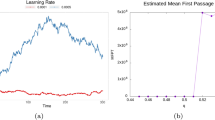Abstract
A formal neuron has been studied mathematically. The spiking behaviour of a single neuron has been considered and the influence of the other neurons has been replaced by an average activity level. Four different kinds of spiking behaviour are predicted by the model: B (bursts), C (continuous), P (periodic) and S (silent) neurons and several real neurons can be classified within these four categories. Some properties of the spiking neuron are calculated: 1) the time between spikes, 2) the spike train length and 3) the silent time. Because these magnitudes can be measured in the laboratory, an experimental validation of the model is proposed.
Similar content being viewed by others
REFERENCES
Arbib, M. (ed.) (1995). Handbook of Brain Theory and Neural Networks. MIT Press
Amit, D. (1989). Modelling Brain Functions. Cambridge Univ. Press.
Connors, B.W. and M.J. Gutnick (1994). Intrinsic firing patterns of diverse neocortical neurons. Trends in Neuroscience 13: 99–104.
Feller, W. (1968). An Introduction to Probability Theory and Its Applications. Vol. 1, Wiley.
Freeman, J.A. and D.M. Skapura (1991). Neural Networks. Addison-Wesley.
Gutfreund, H. and G. Toulouse (Eds.), (1994). Biology and Computation: A Physicist's Choice. World Scientific.
Haykin, S. (1995). Neural Networks: An Introduction. Macmillan-IEEE Press.
Hopfield, J.J. (1984). Neurons with graded responses have collective computational properties like those of two-state neurons. Proc. Natl. Acad. Sci. USA 81: 3088–3092.
Kandel, E.R. (1974). Cellular Basis of Behaviour, Freeman.
Koch, Ch. and I. Segev (Eds.)(1989). Methods in Neural Modelling, MIT Press.
Little, W. A. (1974). The existence of persistent states in the brain. Mathematical Biosciences 19: 101–120.
Llinas, R.R (1988). The intrinsic electro physiological properties of mammalian neurons: insights into central nervous system function. Science 242: 1654–1664.
Peretto, P. (1992). An Introduction to the Modelling of Neural Networks. Cambridge Univ. Press.
Selverstone, A.I. (1974). Structural and functional basis of motion pattern generation in the stomatogastric ganglion of the lobster. Am. Zool. 14: 957–972.
Selverston, A.I. and M. Moulins (Eds.)(1986). The Crustacean stomatogastric Nervous System; A Model for the Study of the Central Nervous System. Springer Verlag.
Turrigiano, G., L.F. Abbot and E. Marder (1994). Activity — dependent changes in the intrinsic properties of cultured neurons. Science 264: 974–977.
Author information
Authors and Affiliations
Rights and permissions
About this article
Cite this article
Miranda, E. How Good are Formal Neurons for Modelling Real Ones?. Acta Biotheor 45, 171–179 (1997). https://doi.org/10.1023/A:1000346408143
Issue Date:
DOI: https://doi.org/10.1023/A:1000346408143




